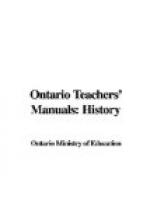THE LESSON
1. Introduce the lesson by a reference to the system of holding land in Ontario. (See lesson on the Feudal System.) Develop the leading principles of freehold tenure. What Act gave the people of Ontario this method of holding land? We are going to learn something about the system of holding land adopted by the French when they ruled Canada. (See Ontario Public School History, Chapter IX, also Ontario High School History of Canada, Chap. VIII.)
2. Under the French the lands of Canada were held in feudal tenure, which means that the King was regarded as the owner, and that rent was paid to him, not altogether in money, but partly in military service. Large portions of land were granted in this way to officers and nobles. An important and imposing ceremony was that at which the lords of manors annually did homage to the King’s representative at Quebec. These seigniors, as they were called, had great powers within their domains. This method of tenure was similar to the system of holding land in France, called the Feudal System.
At this point the teacher might give a short description of the Feudal System. Picture to the pupils the old Feudal castle and its surroundings. Show how ill the common people were provided for in comparison with the lords.
3. Cardinal Richelieu introduced feudalism into Canada about the year 1527. He had two objects in view: (a) to create a Canadian aristocracy, (b) to establish an easy system of dividing land among settlers. This system of holding land came to be known as Seigniorial Tenure. The seignior received vast tracts of land from the King, became his vassal, and in turn made grants to the censitaires, those who held their land on the payment of an annual rental. The censitaires secured habitants to cultivate the soil.
4. The seignior was compelled to clear his estate of forest within a certain time. In order to do this he rented it, at from half a cent to two cents an acre, and received his rent in produce. If the censitaire sold the land which was cleared, he had to pay his seignior one twelfth of the price. If the seignior parted with his estate, he had to pay the King one fifth of the selling price. The forests of Canada were not very attractive to the nobles of France; hence, but few of them settled in this country. Some of the prominent colonists, however, were granted patents of nobility and became seigniors. Prevented by their rank from cultivating the soil, they soon became bankrupt. Then they turned their attention to the fur-trade, and later many of them became explorers and the most gallant defenders of New France.




